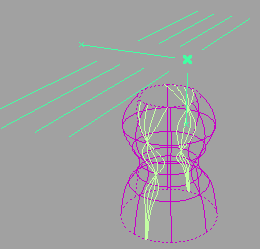 Highlights
Highlights
Creates curves-on-surface corresponding to highlight lines produced by light sources.
Access this tool from the Evaluate palette:

Highlights Control settings
Light Origin
The 3D coordinates of the origin of the first light (center point).
You can set the origin with the highlight manipulator when you use the tool.
Direction Type
Select either Rotation or Vector.
Light Direction
The direction in which the light sources point.
You can set this vector with the highlight manipulator when you use the tool.
Number of Lights
The number of lights from which to create curves-on-surface highlights.
If you use more than one light, the multiple lights are always parallel to each other.
Light Width
The width of the single light source. This option is only available if Number of Lights is 1.
Set the width to 0 to create a single curve-on-surface. Set the width greater than 0 to create two curves-on-surface corresponding to the edges of a wide highlight.
This option has no effect if Visual is turned on.
Light Spacing
The spacing between multiple light sources. This option appears when Number of Lights is greater than 1.
Vector/Plane/Point
Enter the name of a point/vector/plane to position/align the Surface Evaluate manipulator with it. (You can also click a point/vector/plane to align the Surface Evaluate manipulator with it. Or you can select the point/vector/plane and the surface before selecting the tool.)
Subdivisions
The quality of the curve-on-surface projection, from 1 to 6. The higher the value, the more precise the result. Use low values for draft quality, use higher values for final results.
Visual
Draw fast polylines instead of curves-on-surface.
These lines are mainly for display purposes. Although you can pick them (to delete them, for example), you cannot use them to create geometry.
Display Tolerance
When Visual is checked on, this value defines the quality of the visual curves independently of the tessellation tolerance. This lets you set the visual tolerance to a smaller value to get better quality visual curves, without reducing the tessellation tolerance used for shading.

Left: visual tolerance = 0.1 mm. Right: visual tolerance = 0.001 mm
Control Options
Auto Update
Update the curves-on-surface as you change the values in the window.
Create History
Save the history of the new curves-on-surface for later editing. If you turn Create History on, you can modify the surfaces and the curves-on-surface update.
Buttons
Update
When Auto Update is off, use this button to update the curves on surface to correspond to the current options.
Undo All
Undo all the changes made by the tool and return to the original surface.
Next
Finish creating curves-on-surface on the current surface and prompt for a new surface to evaluate.
Create curves-on-surface from highlight data
Pick the surfaces on which you want to create curves-on-surface.
Shift-select the tool.
The Highlights control window opens and the highlight manipulator appears.
Note: Selecting the Visual option draws fast polylines instead of curves-on-surface. These lines are mainly for display purposes. Although you can pick them (to delete them, for example), you cannot use them to create geometry. Leave Visual unselected to create curves-on-surfaces.Click the Go button.
Curves-on-surface are created.
Set the following options in the option window:
- The Number of Lights you want to create highlights from.
- The Light Spacing (if there is more than one light) or the Light Width (if there is only one light).
- Set the Subdivision option from 1 to 6. The higher the number, the more precise the result. Use low values for draft quality, use higher values for final results.
The curves on surface update as the option values are modified. (If they do not, turn on Auto Update or click Update to create the curves-on-surface.)
The manipulator reflects the changes.

Drag different handles on the manipulator to position and orient the light(s), or type exact values into the Light Origin, Light Direction, and Vector/Plane/Point fields of the Highlights window.
The curves on surface update.
Click on additional surfaces to evaluate them, or deselect active surfaces.
Click the Undo All button in the control window to remove the curves-on-surface.